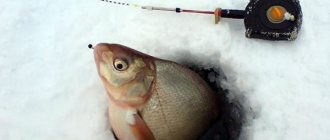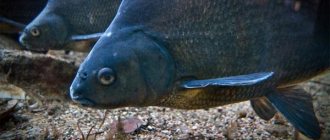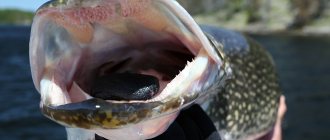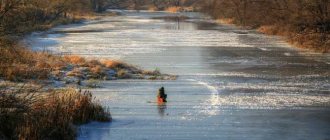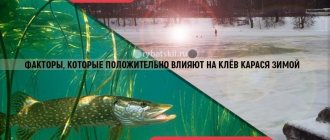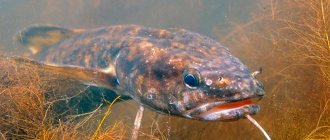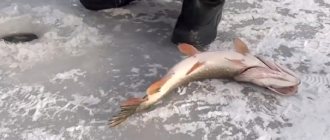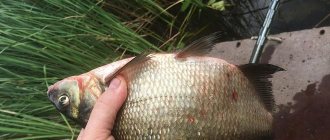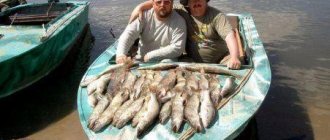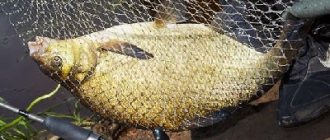Catching bream in winter is not only interesting, but also productive. You can catch both white bream and quite trophy specimens. To successfully catch bream from ice, you need to know the basic habits of the fish, where promising spots are located, what gear to use in different conditions, as well as what bait and groundbait to use.
The success of catching bream in winter depends on many factors - from knowledge of habits and parking areas, to correctly selected tackle, baits and baits
Where to look for bream in winter on a river and reservoir (still body of water)
To guarantee success in ice fishing, you need to accurately identify bream sites. Mostly, difficulties arise for novice fishermen on an unfamiliar body of water. Search for operating points more quickly and efficiently using an echo sounder.
This modern gadget is capable of measuring depth in a few seconds, examining the bottom of a reservoir, and identifying the presence of underwater objects and obstacles. The device will be especially useful when catching bream in the winter on the current. In addition, the echo sounder allows you to see how the fish responds to a specific bait.
Identifying bream using an echo sounder:
If there is no echo sounder, then you need to search for bream on the ice depending on the type of reservoir.
Winter bream sites in medium and small holes in the current
Winter river bream stands near the pits. During the cold season, schools of bream and bream stay near the waterways, on the border of calm water and strong currents. The main food of winter bream is the mollusk, zebra mussel.
Promising places may be the lower sections of channel slopes and hills in depressions. Watering should not be ignored either.
If you plan to fish on a large body of water, then you should work on rocky ridges, where the favorite delicacy of bream often lives. In search of food, fish can explore both the bends of the riverbed and steep cliffs near calm reaches/rifts.
If there is enough food, the bream moves both downstream and upstream.
Bream sites on the current
It is also recommended that the fisherman pay attention to atmospheric pressure indicators; when they are low, then fishing for promising points should be carried out at depth, if they are high, on the middle/upper edges.
Where does bream stand in a pond depending on pressure
Where to look for bream on lakes, reservoirs and other stagnant bodies of water
In a closed, unfamiliar body of water, the deepest areas are often the most productive.
It is more common for bream to remain constant; it does not tend to leave specific places. To hunt large individuals, holes are made at a distance of 8-9 meters from the workers and they are allowed to rest.
Winter bream can easily be scared away if you do not take precautions, make noise on the ice, or fuss too much.
If fishing takes place on a lake, then the deepest places where there are exits to the shallows will be effective. Differences in the bottom surface will be a priority, but level tables may be unpromising.
Where to look for bream in winter on the reservoir
Nuances and secrets
Successful catching of bream in winter from ice on the current (and indeed, everywhere) requires compliance with some small details that can greatly affect the bite. Here are some life hacks from experienced breamers:
- When planting bloodworms in a bunch, one or two larvae should be crushed with your fingers to enhance the smell. This fish has an excellent sense of smell.
- You cannot flicker over the hole from the direction of the sun - bream are frightened by changes in illumination in the light column under the ice.
- You should not make noise, stomp, shuffle your feet on the ice or drop objects on it, as this can scare away large fish.
- When fishing with gear with a long release of the working part under the ice (dropper, helicopter, skate), you should not walk or make noise on the ice in the area where the hooks with bait are approximately located.
- You should have a baited hole in stock, since the bream, breaking the bottom soil under the working one, sooner or later leaves it.
- The breams begin to bite first, and only later can large fish approach the bait.
- Sometimes the fish takes not from the bottom, but at a short distance from it
- When fishing at night in winter, hooks with drops of phosphorus varnish or light-accumulating jigs work well.
- You need to experiment with bait. One bloodworm, two or a bunch, a sandwich with maggots, etc. Bream, especially in the middle of nowhere, can be very finicky.
Video of winter fishing for bream on the current:
Peculiarities of catching bream in different periods of winter
On the first ice, you can count on a catch if you develop a working square after familiarizing yourself with the bottom surface. It is better to look for bream at the beginning of winter on the edges and dumps. It is promising to make holes in a checkerboard pattern at a distance of 10-15 m from each other.
But places with a muddy bottom should not be considered for fishing. Bream prefers to live in areas with a sandy, clay bottom.
In December, when fish activity is still at a high level, use better-catching jigs to attract fish.
In the middle of winter, which is also what fishermen call the wilderness, there is a low concentration of oxygen in the water. Underwater inhabitants move to a depth of 7-10 m; at this moment, almost all underwater inhabitants leave the shallow waters, with the exception of outright small fry.
It is especially promising to look for fish in areas with weak currents. Deep-sea channels should extend from the depressions along the riverbed. When the thaw sets in, the working depth shifts by 2-3 meters.
At very low temperatures, fish stay in pits.
Advice! Studying a reservoir in open water simplifies and speeds up the process of finding promising fishing spots. In the fall, it’s easy to measure the depth, study the bottom topography and mark bream trails.
Catching large bream in winter:
Bait of bream
Bait can be very useful when fishing for bream in winter, but its use is not always so clear. Bream is a fish with fairly established “paths” and habitats and, especially in winter, no bait is often able to move it from them. On a homogeneous bottom surface, bait usually attracts fish from an area with a radius of 5 - 10 m. As for its quantity, for example, bait sufficient for a good bite on the first ice will be too much for sluggish fish in the dead period of mid-winter. Therefore, you need to try all the time.
Groundbait recipes
There are no definitely working recipes for which bait to use. The basic principles of its creation are as follows:
- the bait must contain bloodworms, at least 30–50 g per liter of bait;
- The smell of the bait should be attractive to the fish, but not too much, and in different bodies of water, these smells are different, you need to try it;
- The calorie content of the bait should correspond to the activity of the fish during a given period;
- there should be no lumps in the bait; to do this, it must be rubbed through a sieve;
- Winter bait does not require a binder.
Taking all this into account, let’s look at a few simple, folk bait recipes:
Bait for bream with peas
As you know, peas are one of the favorite baits of bream; the first bait is made on its basis.
Ingredients:
- breadcrumbs (ordinary grated ones can be used) – 500 g;
- roasted sunflower seeds – 75 g;
- oat flakes – 100 g;
- crushed polished peas – 200 – 300 g.
Pour water into the pan in a 2:1 ratio with peas. When the water boils, add the peas and cook over low heat until they are cooked into a homogeneous mass.
Rusks, oatmeal and seeds are passed through a meat grinder or coffee grinder. Mix the ground seeds, crackers and flakes in a bowl or basin and then pour them with boiled pea porridge.
Knead the resulting mixture with your hands until smooth and transfer it to a plastic bag. The resulting bait should easily form into a lump and disintegrate; when it gets into the water, it gives a good cloud of turbidity that attracts fish.
Groundbait with bloodworms
The second mixture, in addition to the classic millet and crackers for bream, contains bloodworms, so it is advisable to use it when the fish is more active, on new ice or at the end of winter.
Ingredients:
- millet – 500 g;
- bread crumbs, regular or bread crumbs - 300 g;
- roasted sunflower seeds or makukha – 100 g;
- sunflower oil – 50 g;
- bloodworm – 150 – 200 g.
Cook the porridge in a 1:2 ratio with water until the water completely disappears. We pass the crackers through a meat grinder, and then fry the resulting crumbs in sunflower oil. We also pass the seeds through a meat grinder. Mix all ingredients in a bowl or immediately in a thick plastic bag. Already while fishing, we add small or chopped large bloodworms to the mixture.
Groundbait with bloodworms
Video recipe: Effective bait from pearl barley and millet
How to feed properly
When fishing for bream in winter, you should remember that the earlier the bait is introduced, the better. In winter, the fish are not very active, and accordingly, after feeding, they react longer. Taking this into account, experts advise feeding after dark for fishing at dawn, and before sunset for night fishing. During the day, the bite begins about an hour after feeding the hole.
The bait is thrown using special feeders. Sometimes the main and supplementary feeders are separated, the latter being smaller in size.
It is believed that bream requires a lot of bait, but here we need to take into account what we feed and at what period. The more active the fish, the more bait you need. It is most practical to initially use vegetable bait, with a small amount of bloodworms, and then keep the fish at the hole in small (3 - 5 g) portions. When supplementary feeding, the feeder should be opened not at the bottom, but a couple of meters higher, so as not to scare away the fish.
Suitable weather conditions for bream fishing: pressure, wind and stability
Bream is active when the weather is stable. It feeds fully, responds well to bait when there are no sudden changes in temperature, atmospheric pressure, and the wind is directed in one direction. The fish feels normal at atmospheric pressure in the range of 735-745 mm.
It is very important for successful fishing in winter that the weather does not change for at least two to three days. Particularly good results can be expected when heavy snow falls. The catch on such days can consist of both bream and roach.
What does winter bream bite on and what does it like?
The right bait/attachment is almost half the success when catching bream from the ice. An angler should have several options in his arsenal. The priority is:
- Bloodworm . This is a versatile grub that is always a win-win solution. You can find larvae in the mud. To catch a white bream, two bloodworms are used, and for large individuals, a bunch of 5-8 pieces is used.
- Mormysh . The bait works on any body of water. It can also be used boiled. It is interesting for fish due to its rich orange color and pleasant smell. Mormysh is also recommended to be used as an ingredient in a bait mixture.
- maggots for winter bream during the first ice and at the end of winter.
- Plant attachments . Fish are attracted by semolina, dough, and bread. It is better to use them on the last ice.
- Lard is a delicacy for bream, although not everyone knows about it.
Catching bream with lard and other baits in winter:
How to catch bream in the winter on the current
Ice fishing for bream in the current requires special equipment for fishing rods that can withstand the force of the current. For this purpose, weighted versions of winter fishing rods and ice fishing rods are used.
Fishing rod
The equipment of a winter fishing rod for catching bream in the current should hold the bait under the hole, and not drag it along the bottom. On a flow of low and medium intensity, you can use a float, provided that the current cannot drag it out of the hole. On a stronger stream, a nodding fishing rod with a sliding sinker, a stopper and a leash is suitable - in common parlance, a weight . In this case, the nod is selected so that the force of the water does not bend it completely, otherwise the bite will not be visible.
The thickness of the fishing line depends on the planned size of the fish: for bream, the thinnest regular or fluorocarbon fishing line 0.1-0.12 mm is enough, for large bream, respectively, 0.12-0.25 mm. In sparsely populated areas, bream catches about 3 mm in winter and is not afraid. In more urbanized regions, where fish are few and wary, it is necessary to use fine tackle.
How and what to feed bream: recipes
In winter, you should not add too many flavors to bait mixtures. Otherwise, the fish, sensing something is wrong, will quickly leave the fishing spot. The bait is prepared from:
- steamed millet;
- Hercules;
- crushed wheat grains;
- semolina;
- ground sunflower seeds;
- bran;
- feed bloodworm;
- chopped worm;
- maggot.
For information! In winter, it is not recommended to overfeed bream; it is better to feed bait in doses.
When fishing in a current, the consistency of the bait composition should be quite dense and viscous, and in calm water it should be loose and dusty. At the beginning of the season, a high-calorie mixture works better.
Recipe No. 1:
- Pour 150 grams of millet into a suitable container, pour boiling water over it, and leave to steam.
- Add 150 grams of corn flour and 150 grams of bran, 1 tsp. Sahara.
- Use bloodworms (3 matchboxes) and a pinch of salt.
- Add some clay to thicken the mixture.
- At the fishing site, bring the bait to the required consistency using water.
Recipe No. 2:
- Boil rice (100 g) until half cooked.
- Add 100 grams of sunflower cake, 200 grams of breadcrumbs, the same amount of bran, 2 tsp. chopped coriander.
- Add maggot (3 matchboxes) to the composition.
- Mix all ingredients.
For successful fishing you need feeding
A few more features of catching winter bream
If hunting is carried out in the current, then it is better to use different types of jigs and heavy float tackle. It works well with large, heavy baits. It is better to select them experimentally, taking into account the fishing conditions and the nature of the reservoir. A garland of little devils, as well as a helicopter and a harvester, also show good results in the current.
On calm bodies of water, zonal tactics are used, thanks to which it is possible to identify promising places as accurately as possible. You can catch bream in reservoirs in winter using both a float and a jig.
If the fish is passive, then delicate, highly sensitive baits are used. For larger specimens, more reliable gear is suitable.
Winter bream fishing in a tent at night
If you hunt bream at night, then you simply cannot do without a tent. Candles will be needed as aids. They will help both light the tent and heat it.
This is the easiest way to increase comfort while ice fishing. For everything to go well, you need to study the reservoir during the day, determine the operating points and feed them. Night fishing, in terms of gear, choice of bait and bait, is practically no different from daytime fishing, it only requires more careful preparation.
Winter fishing for bream in 2021 in a tent with an overnight stay - current video:
Winter gear for catching bream in the current
To catch bream on the current in winter, use such gear as a float rod, a descender, a rocker, and a winter feeder.
We recommend reading: How to distinguish a silver bream from a white bream quickly and accurately
Winter float rod
The float tackle used in the current differs from that used in still water. It has a number of features:
- Larger 2-3 piece bream float;
- Thick fishing line up to 0.2 - 0.22 mm cross-section;
- A heavy load in the form of an olive weighing up to 10 g;
- Long (up to 0.5 m) leash.
In addition to the float, such tackle is often equipped with a rigid and long guard made of a flat metal spring.
Descent (harvester, locomotive)
Homemade fishing gear for river fishing for bream is assembled as follows:
- A 20-30-meter supply of main fishing line with a cross-section of 0.28-0.3 mm is wound onto a 50-mm reel of a winter fishing rod with a handle;
- The line is passed through a twisted spring nod with a spherical bite indicator at the end, attached to the top of the whip. The length of such a gatehouse must be at least 15 cm.
- A swivel with a fastener is put on the fishing line;
- With the help of 2-3 silicone stoppers attached to the main fishing line, the swivel with a clasp restricts movement along it;
- A 10-15 cm leash with a homemade small feeder or a sinker weighing 30-40 g is fastened to the fastener;
- On a section of the main line located behind the stoppers, 3-5 leashes, each 20-30 cm long, are tied in increments of 50-70 cm. A large oblong-shaped jig (Uralka, Kaplya) weighing over 0.6 g is tied to the end of each leash;
- A small spherical sinker or a large carp jig weighing over 2 g is tied to the end of the main line.
Rocker
A rocker is an effective tackle for catching bream in winter on a river with a current. It consists of the following parts:
- A solid lever (frame) with 2 arms, which is a piece of steel wire with a length of 109-12 cm of wire;
- Hanging ring in the middle of the frame;
- Two rings for leashes at the ends of the frame;
- Two short leashes 3-4 cm long;
- Loads weighing from 2 to 20–25 g.
We recommend reading: Winter carp fishing: choosing gear and fishing tricks
Such equipment is tied to the main fishing line with a cross-section of 0.16-0.18 mm. The signaling device is usually a 2-part float.
Helicopter
This type of bottom gear consists of the following parts:
- A 15-meter working section of the main fishing line has a reel attached at one end and a swivel at the other. In the middle of the working segment, 3-4 hooks No. 10-12 are tied every 20-30 cm;
- Main line with a 30-40 gram pyramidal sinker;
- A fishing rod with a rigid nod made of a twisted or flat metal spring.
The helicopter is assembled as follows: hooks are tied to a piece of working line using a loop-to-loop knot, and a reel and a single swivel are attached to its ends. Next, the main fishing line is passed into the free eye of the swivel and a sinker is tied to its end. A lightweight aluminum profile is used as a reel for this gear.
Winter feeder
You can catch bream in winter with constant feeding using equipment such as a winter feeder. The main components of this analogue of a summer feeder are:
- Short carbon rod 50-70 cm long with 0.5 oz (about 14.5 g) dough
- Inertia-free coil size 1500-2000;
- Main line with a cross section of 0.18-0.2 mm;
- A feeder weighing no more than 20 g or a small sinker;
- A leash 0.5-1.0 m long made of fishing line with hook No. 12-14 at the end.
When fishing in winter, two summer feeder rigs are used: the Paternoster and the Gardner Loop.
Tips from experienced anglers
Even a beginner can catch winter bream from the ice. Considering some points:
- use high-quality equipment;
- use a feeder to deliver bait to the fishing point;
- darken the hole with snow, rubber, plywood;
- do not make too sharp cuts;
- start fishing 15-20 minutes after feeding the hole.
Bream are very cautious in winter and it is quite easy to spook them. There is no need to use a cord; a thin fishing line up to 0.16 mm thick is sufficient. Fluorocarbon and polypropylene monofil have proven themselves well. Going out for bream fishing is equally effective both during the day and at night.
